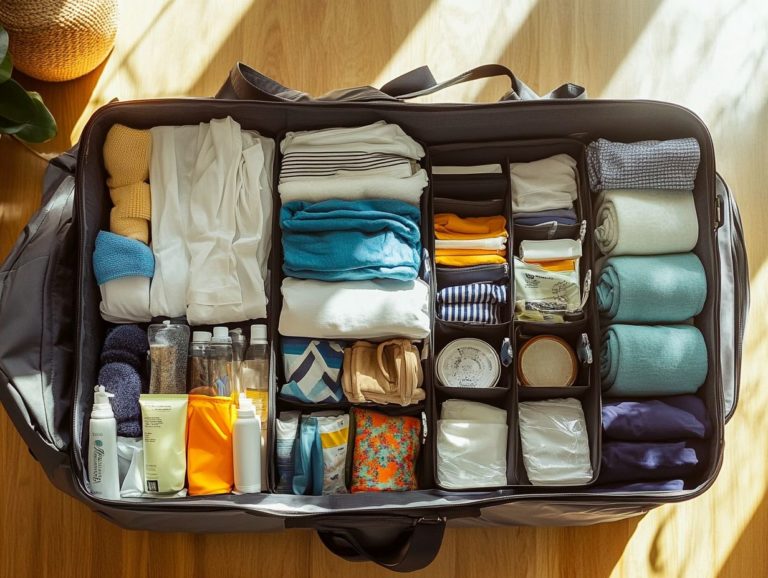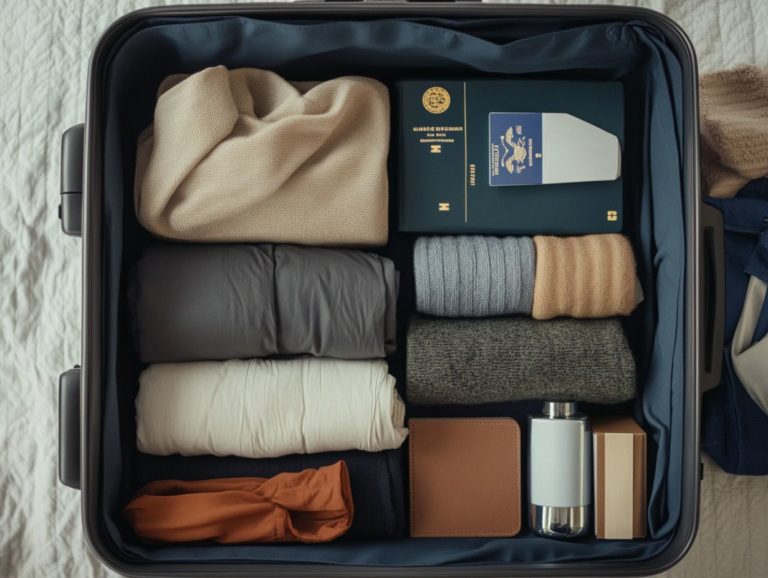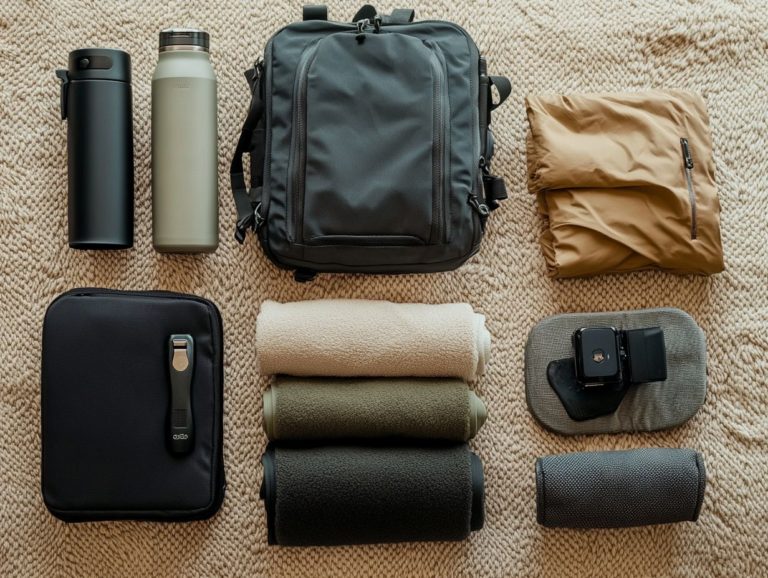10 Packing Mistakes to Avoid
Packing for a trip can evoke a mix of excitement and overwhelm, especially when you aim to have everything you need without the burden of excess baggage.
Many travelers unwittingly stumble into familiar traps that lead to unnecessary stress and frustration. This article outlines ten packing mistakes to avoid, from overpacking and overlooking baggage restrictions to forgetting essential items.
By confronting these pitfalls head-on, you can pack more intelligently and elevate your travel experience. Get ready to streamline your packing process and embark on an exciting journey!
Contents
- Key Takeaways:
- 1. Overpacking
- 2. Not Checking Baggage Restrictions
- 3. Not Bringing Necessary Items
- 4. Not Planning for Weather Changes
- 5. Packing Too Many Similar Items
- 6. Forgetting Important Documents
- 7. Not Considering Weight and Size Restrictions
- 8. Not Packing a First Aid Kit
- 9. Not Using Packing Cubes or Organizers
- 10. Not Checking for Prohibited Items
- How to Efficiently Pack for a Trip?
- Frequently Asked Questions
- 1. What are the most common packing mistakes to avoid?
- 2. How can overpacking be a mistake?
- 3. Why is it important to plan ahead when packing?
- 4. How can using packing cubes or compression bags help with packing?
- 5. Why is using a carry-on bag important?
- 6. What are some consequences of not properly securing liquids or toiletries while packing?
Key Takeaways:
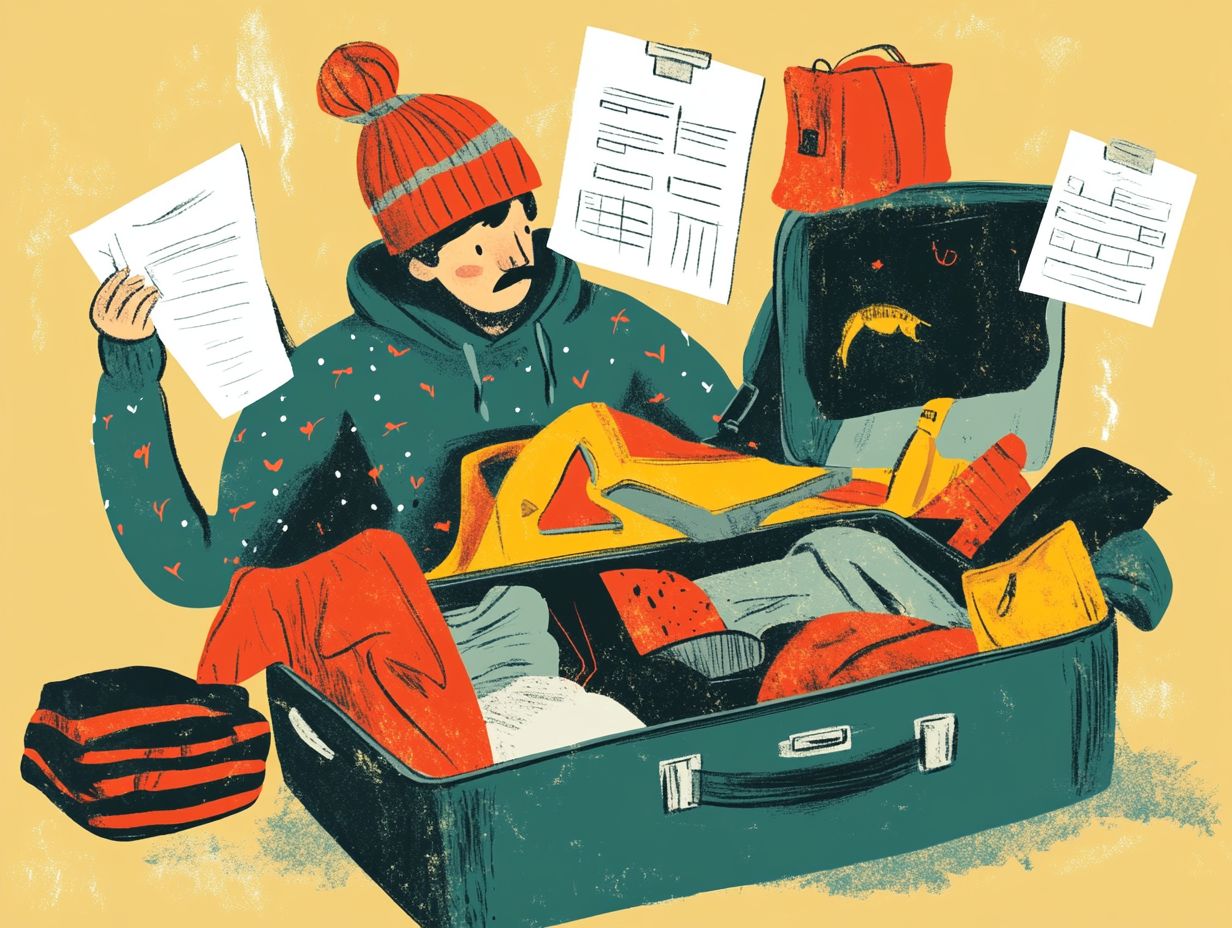
- Avoid overpacking by planning and bringing only the essentials.
- Check baggage limits to dodge extra fees.
- Pack for weather changes to stay prepared.
1. Overpacking
Overpacking is a common pitfall that many travelers encounter. It often leads to unnecessary stress and dreaded baggage fees. Understanding how to sidestep overpacking mistakes is essential, whether you re a seasoned travel writer or a digital nomad wandering through Japan, Europe, or the U.S.
Use packing tips wisely to lighten your load. Ensure you have all the essentials like packing cubes, a first-aid kit, waterproof hiking boots, and a toiletries bag, without the weight of extra clothes dragging you down.
This approach enhances your travel experience and saves you precious time at the airport. Consider versatile clothing options that can be mixed and matched to create multiple outfits from just a few pieces. Utilizing packing cubes helps you maintain organized compartments, making it easy to find essential items without the chaos of a disheveled suitcase.
Prioritize lightweight fabrics and limit yourself to a solid pair of sturdy shoes and flip-flops, which can adapt to various situations.
Streamlining your packing process is the key to embarking on a stress-free journey.
2. Not Checking Baggage Restrictions
Many travelers often overlook the importance of checking baggage restrictions before their journey. This oversight can result in unexpected fees and complications at the airport, especially when dealing with rules set by airport security for what you can bring on flights.
Understanding the intricacies of various airlines’ baggage policies is crucial, as these can differ greatly in weight limits and prohibited items. Ignoring these guidelines can lead to significant charges and delays during check-in or boarding.
To sidestep such inconveniences, pack your essentials like clothing and toiletries in a well-organized manner. Using packing cubes optimizes space and keeps everything tidy. Always opt for lightweight items and look for multi-purpose gear, items that serve more than one function, to stay within weight limits.
Familiarizing yourself with commonly prohibited items can save you from a frustrating experience at the security checkpoint.
3. Not Bringing Necessary Items
You often overlook essential items when packing, which can lead to discomfort and inconvenience during your journey. A well-curated list of travel essentials like a first-aid kit, toiletries bag, sunscreen, and even athletic shorts can truly make all the difference.
Consider a hiking trip, for instance. Carrying a reliable first-aid kit ensures that you can promptly treat minor injuries, allowing you to continue your explorations without unnecessary delays. Similarly, a well-stocked toiletries bag is crucial for maintaining hygiene, especially in remote locations where access to facilities may be limited.
Sunscreen is another must-have; it protects your skin from harmful UV rays during beach vacations or outdoor excursions and helps prevent those painful sunburns that could ruin an otherwise perfect day. Proper clothing choices, like breathable athletic shorts, offer comfort and flexibility, essential for adapting to various terrains and climates whether you re navigating cobbled streets in a charming city or hiking up a rugged mountain trail.
By packing thoughtfully crafted essentials, you can significantly enhance your travel experience.
4. Not Planning for Weather Changes
Failing to plan for weather changes can easily transform what should be a dream vacation into a frustrating ordeal. By incorporating smart packing tips that account for varying climates and conditions, you can ensure that your trip remains enjoyable, come rain or shine. Think essential items like:
- Waterproof hiking boots
- Extra clothing
When considering the weather at your chosen destination, it’s wise to do a bit of research on local forecasts and seasonal patterns. This way, you can accurately gauge the conditions you might encounter. Weather apps or websites can serve as your reliable guides, providing a comprehensive view of what to expect and helping you make informed decisions about your clothing and gear.
Beyond those waterproof boots, packing versatile layers is a must. Lightweight, quick-drying fabrics work wonders for warm days, while a breathable, packable jacket keeps you ready for any sudden rain or chill. Don t forget about sweaters or fleeces! These can be easily added or removed as temperatures shift, ensuring your comfort is maintained throughout your adventures.
5. Packing Too Many Similar Items
One of the most common packing blunders is bringing too many similar items. This not only wastes precious space but also limits the versatility of your outfits during your travels. Finding the right balance in your wardrobe is essential for efficient packing.
By choosing versatile pieces, you can create multiple outfits from fewer items, making the packing process significantly smoother. For example, a simple black dress can be elevated with accessories for an evening out or paired with a denim jacket for a relaxed day of sightseeing.
Similarly, a lightweight scarf can double as a chic wrap for those cooler evenings and a handy cover-up for beach days. Emphasizing multifunctional clothing streamlines your packing experience while inspiring creative combinations. This ensures you re ready for various occasions without the burden of excessive baggage.
6. Forgetting Important Documents
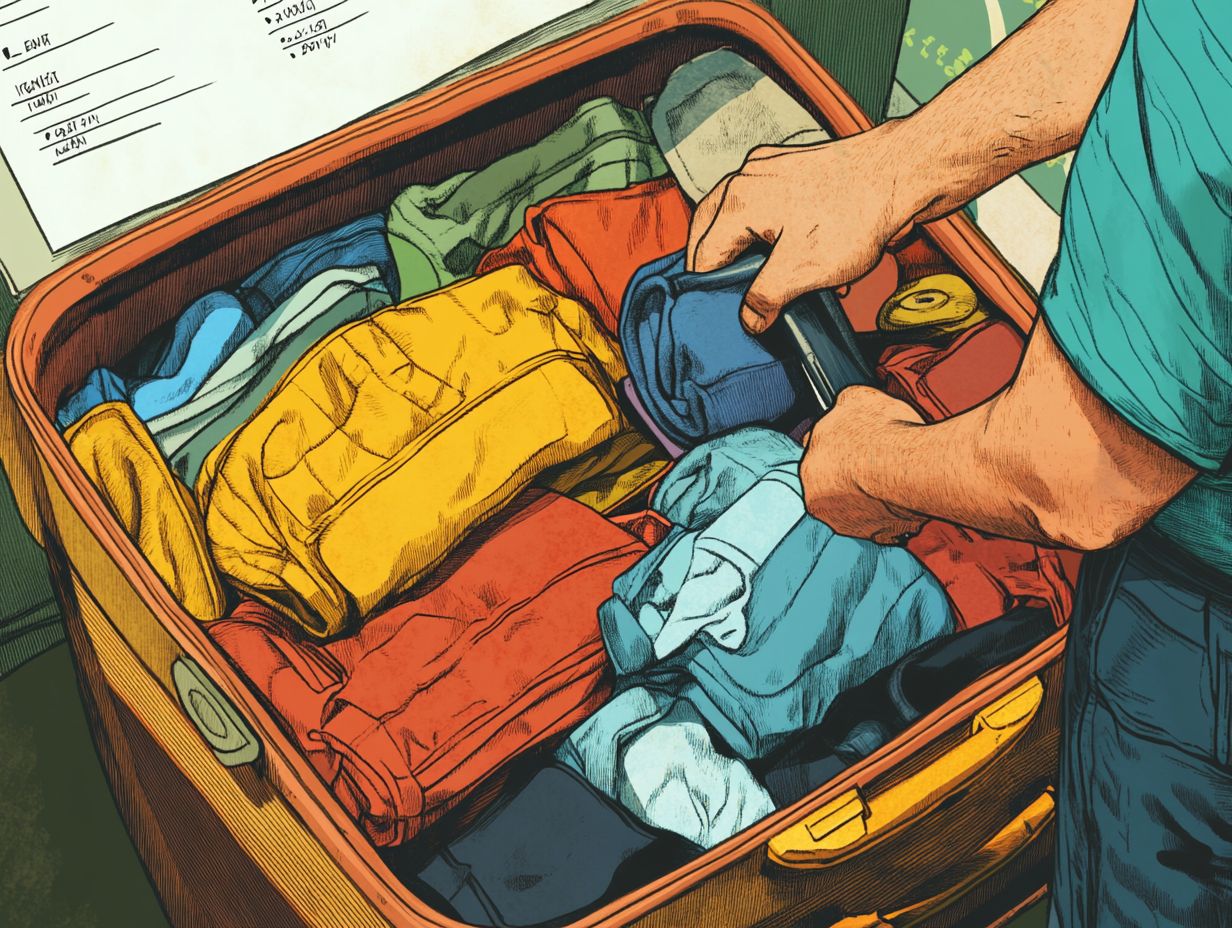
Forgetting important documents can lead to significant complications during your travels. Securing essentials like your travel insurance information, passport, and a reliable travel guidebook should be at the top of your preparation list.
It s also vital to consider the specific requirements of your destination, which may include visas, health records, and vaccination certificates. Familiarizing yourself with the regulations ahead of time can help you avoid unexpected issues at border crossings or during check-ins.
To keep everything organized, using a dedicated travel wallet is a smart move, as it allows for easy access to critical documents when you need them. Investing in digital backups by scanning vital records can provide invaluable peace of mind, ensuring that essential information is readily available in case of loss or theft.
By employing these best practices, you enhance your efficiency and contribute to a smoother and less stressful travel experience.
7. Not Considering Weight and Size Restrictions
Ignoring weight and size restrictions can lead to some rather unpleasant surprises at the airport. Understanding these limits is essential to avoid pesky extra charges and ensure a smoother journey with all your travel essentials.
To navigate these regulations effectively, weigh your luggage beforehand to make sure it aligns with your airline’s specified requirements. Utilizing travel tools like luggage trackers helps you keep tabs on your bags and adds an extra layer of security, giving you peace of mind.
Thoughtful packing decisions, such as opting for versatile clothing and minimalist toiletries, help you stay within those limits. Creating a packing list can prevent impulsive additions and allow you to prioritize essential items, ultimately leading to a more organized and stress-free travel experience.
8. Not Packing a First Aid Kit
Neglecting to pack a first-aid kit is an easily overlooked mistake that can come back to haunt you. Having a basic first-aid kit handy can be invaluable during your travels, ready to tackle minor injuries and health issues. Whether you re trekking through a rugged trail or lounging on a sun-drenched beach, the right supplies can ease your worries and enhance your overall experience.
A well-stocked kit should include essentials such as:
- Adhesive bandages: essential for treating cuts quickly.
- Antiseptic wipes: to fend off infections.
- Pain relievers: for pesky headaches or muscle pain.
- Gauze pads: for larger wounds.
- Tweezers: for removing splinters.
- A thermometer: for quick checks when a fever strikes.
Personalizing the kit to suit your health needs is vital. If allergies are a concern, consider adding antihistamines. Always consider adding a snakebite kit if traveling to remote areas. Keep destination-specific risks in mind when tailoring your supplies.
9. Not Using Packing Cubes or Organizers
Neglecting to use packing cubes or organizers can quickly turn your suitcase into a chaotic mess, making it nearly impossible to locate your travel essentials when you need them. Packing cubes and organizers help you organize your belongings, ensuring that everything from clothing to toiletries has its designated space.
This not only maximizes available space but also streamlines the packing and unpacking process. This is especially beneficial for both short getaways and longer trips that involve multiple destinations.
For weekend escapes, a set of smaller cubes can separate your outfits perfectly, while larger organizers can provide invaluable help for longer vacations. Opting for color-coded cubes grants you swift access to your items, eliminating the need to search through your entire suitcase.
By incorporating these practical aids into your travel routine, you can enjoy a more stress-free experience, effortlessly finding what you need when you need it.
10. Not Checking for Prohibited Items
Neglecting to check for prohibited items before your trip can lead to significant delays and inconvenience at security checkpoints. Understanding TSA regulations is essential for a smooth travel experience.
A variety of items are commonly restricted, including sharp objects like knives, sporting equipment, and liquids exceeding three ounces. Be mindful of certain electronics and batteries, along with flammable materials.
To ensure peace of mind, creating a packing checklist is invaluable. Your list might include:
- Verifying: that any medication is in its original container.
- Checking: if personal grooming items comply with size restrictions.
- Confirming: whether specific food items are allowed.
Stay informed about the unique regulations of different airlines and destinations, as rules can vary significantly, impacting your overall travel plans.
How to Efficiently Pack for a Trip?
Efficient packing for your trip demands a strategic mindset to ensure you include all essential travel items while avoiding common packing pitfalls. Whether you re planning a weekend escape or embarking on a multi-destination journey, adopting a lightweight packing approach can greatly enhance your travel experience.
To kick things off, creating a checklist is crucial it allows you to prioritize your essentials and focus on what truly matters instead of whimsical packing. Start with the basics: clothing and toiletries, then consider any specialized gear you might need for specific activities.
You can optimize your packing space by:
- Rolling clothes instead of folding them.
- Utilizing packing cubes: small containers that help organize your clothes.
- Stashing smaller items inside your shoes.
Keep in mind to tailor your packing strategy to the duration and nature of your trip. For instance, a beach holiday may call for bulkier items like towels, while a city adventure might benefit from lighter, more versatile layers. Minimizing weight not only makes your travels easier but can also help you avoid pesky airline baggage fees.
What Are the Essential Items to Pack for Every Trip?

Every trip you embark on demands a carefully curated selection of essential items that profoundly influence your comfort and safety. From a well-stocked first-aid kit and a toiletries bag to versatile clothing options and sunscreen, knowing what to pack is fundamental to ensuring a successful journey.
Health products like insect repellent will keep those pesky bugs at bay. Hygiene products provide a sense of cleanliness, making any uncomfortable situation far more bearable.
In terms of clothing, prioritize versatility; this allows you to effortlessly adapt to various climates and activities. A sturdy pair of walking shoes is your trusty ally, offering the comfort and support needed during long days of exploration.
Don t forget to pack travel-sized sunscreen. It not only shields you from harmful UV rays but also promotes overall skin health, allowing you to enjoy your outdoor adventures without a hint of worry.
How Can One Avoid Overpacking?
Avoiding overpacking is a challenge many travelers encounter. While it may seem daunting, effective packing strategies and lightweight techniques can truly enhance your travel experience.
Start with a packing list to see what you really need for your trip. This thoughtful approach encourages you to focus on versatile clothing items that can be mixed and matched for various occasions, significantly reducing the number of pieces you need to bring.
Consider utilizing space-saving techniques, such as rolling your clothes instead of folding them, to maximize your luggage capacity and minimize bulk. As you evaluate each item s necessity, ask yourself questions like, Will I wear this? or Does it serve multiple purposes? This reflective process leads to a streamlined packing experience, resulting in a lighter load and a more enjoyable adventure ahead.
What Are the Best Packing Tips for Different Types of Travel?
Packing tips vary greatly depending on the type of travel you re undertaking. Whether you re off on a business trip, a family vacation, or a thrilling backpacking adventure, knowing the specific essentials you need can make your preparations much smoother.
Each situation comes with its unique set of requirements, highlighting the necessity of customized packing lists. For example, business trips call for formal attire and essential tech gadgets, while family vacations demand a thoughtful selection of items to keep the kids entertained and comfortable.
In backpacking, the focus shifts to lightweight, versatile gear that won t weigh you down. Incorporating eco-friendly packing options like reusable bags, biodegradable toiletries, and sustainable clothing can elevate any travel experience. This enhances your convenience and minimizes your environmental footprint, allowing you to embark on your adventures with a clear conscience.
How Can One Pack for Multiple Destinations in One Trip?
Packing for several destinations can be a bit tricky, but with smart strategies, you can easily manage it! Focus on clothing versatility and efficient packing tips to set yourself up for success.
To effectively navigate varying climates and activities, carefully consider the weather patterns and planned outings for each location. For example, layering adaptable clothing allows for smooth transitions between warm and cooler environments, maximizing your suitcase space.
Utilizing technology, such as travel guidebooks and mobile apps, can streamline your itinerary management, keeping you organized and informed throughout your journey. By blending classic pieces with smart, tech-friendly outfits, you ll maintain a stylish yet functional wardrobe that suits any occasion whether you re casually sightseeing or attending formal dinners.
What Are the Common Packing Mistakes Made by Travelers?
Packing mistakes can ruin your travel experience. Common errors include overpacking and forgetting essentials, like your toiletries.
One major mistake is forgetting to check the weather first. This can lead to packing the wrong clothes, such as heavy coats for a tropical trip or sundresses for chilly destinations.
To avoid this, make a packing list based on your activities and the weather forecast.
Another common mistake is failing to pack versatile outfits, which can clutter your luggage with unnecessary items. Choose clothing that you can easily mix and match to save space and give yourself more outfit options.
Packing smart can transform your travel experience! These insights highlight the importance of strategic packing, ensuring that your travels are smoother and more enjoyable.
Frequently Asked Questions
1. What are the most common packing mistakes to avoid?

The 10 packing mistakes to avoid include overpacking, not planning ahead, not checking airline baggage restrictions, not using packing cubes or compression bags, and not using a carry-on bag. To learn more about these pitfalls and how to steer clear of them, check out this guide on how to avoid packing mistakes. Additionally, make sure to properly secure liquids or toiletries, pack versatile clothing, consider the destination’s climate, label bags, and leave room for souvenirs.
2. How can overpacking be a mistake?
Overpacking can lead to heavy, bulky bags that are difficult to transport and can result in additional fees for overweight baggage. It can also limit flexibility during the trip and make it harder to find items in your suitcase.
3. Why is it important to plan ahead when packing?
Planning ahead allows you to make a packing list, gather necessary items, and properly organize and pack them in your suitcase. This can help avoid last-minute stress and the possibility of forgetting important items.
4. How can using packing cubes or compression bags help with packing?
Packing cubes or compression bags can help organize and compact items in your suitcase, making it easier to fit more items into a smaller space. This can also help keep clothes and other items wrinkle-free during travel.
5. Why is using a carry-on bag important?
Using a carry-on bag can save time and money by avoiding checked baggage fees and the possibility of lost or delayed luggage. It also allows for easier and quicker movement through airports and can be used to keep important items close at hand during your trip.
6. What are some consequences of not properly securing liquids or toiletries while packing?
Not properly securing liquids or toiletries can result in spills that damage other items in your suitcase. It can also lead to delays and additional security checks at the airport, as well as the possibility of having to discard items that do not meet airline restrictions.

